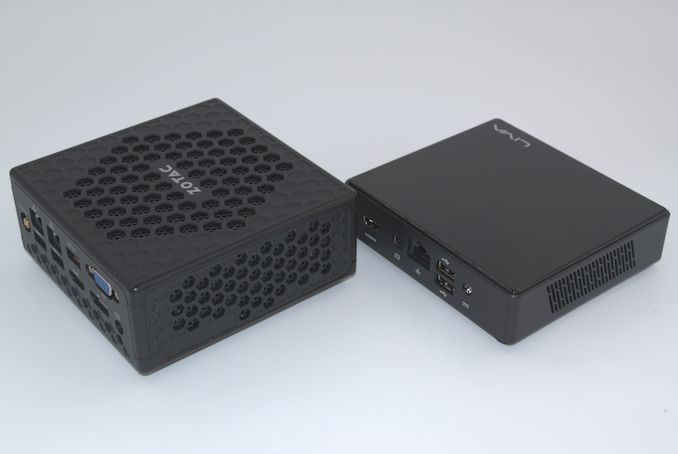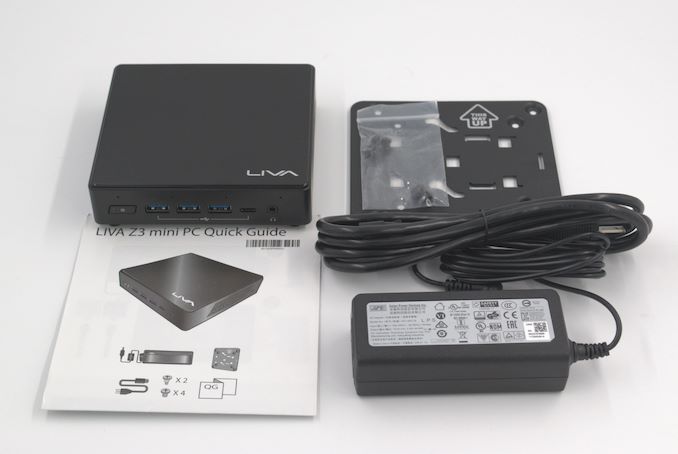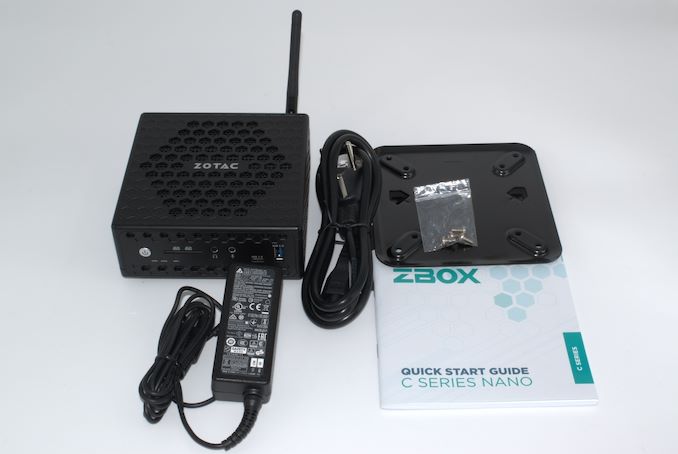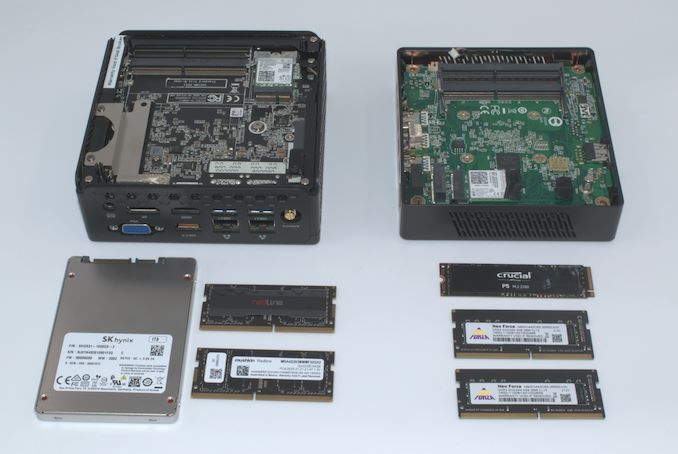Jasper Lake Fanless Showdown: ECS LIVA Z3 and ZOTAC ZBOX CI331 nano UCFF PCs Review
by Ganesh T S on July 8, 2022 8:30 AM EST- Posted in
- Systems
- ZOTAC
- Fanless
- ECS
- Passive Cooling
- UCFF
- Mini-PC
- Jasper Lake

Intel's Jasper Lake series of products (based on the Tremont microarchitecture) was launched in early 2021. Since then, we have seen a steady stream of notebooks and motherboards / mini-PCs based on those processors getting introduced in the market. Ultra-compact form-factor (UCFF) machines based on the Atom series offer attractive entry-level options in the NUC domain. Their low-power nature also lends itself to passively cooled designs.
Intel's Jasper Lake SKUs are a follow-up to Gemini Lake. Back in 2018, we had reviewed two different Gemini Lake UCFF PCs - the actively cooled June Canyon NUC from Intel, and the passively cooled LIVA Z2 from ECS. For Jasper Lake, we have sourced four different UCFF PCs - two passively cooled systems using 6W TDP processors, and two actively cooled ones using 10W TDP processors.
Today's article provides a detailed look into the performance and features of the two passively cooled systems - the ECS LIVA Z3 and the ZOTAC ZBOX CI331 nano. Both of them are based on 6W TDP processors, with slight variations in frequency and iGPU capabilities. The two vendors have also adopted different approaches to the power limits, making for unexpected performance impacts. In addition to an investigation into the capabilities offered for traditional PC workloads, we also go deep into the thermal design to provide insights into what makes fanless systems satisfy user requirements.
Introduction and Product Impressions
Intel's Apollo Lake SoCs (Goldmont-based) introduced in 2016 were quickly followed by Gemini Lake (Goldmont Plus) in late 2017. However, the delays related to 10nm manufacturing resulted in a significant gap before the Tremont-based Jasper Lake products made an appearance in early 2021. Compared to Gemini Lake, the new Jasper Lake products have improved CPU performance (Intel claims a 33% uplift) with an updated microarchitecture and larger caches. The integrated GPU is also clocked higher with additional EUs. Intel On the system front, faster expansion options are available, with up to 8 Gen 3 lanes (compared 6 Gen 2 lanes in Gemini Lake), 14 USB ports (up to 10 Gbps) (compared to 8 ports up to 5 Gbps in Gemini Lake). Jasper Lake also integrates a Wireless-AX MAC, allowing for cost-effective systems with Wi-Fi 6 support. Manufacturers can adopt or take advantage of these features in a varied manner to bring differentiated products into the market.
Similar to our Apollo Lake (Intel Arches Canyon and ECS LIVA Z) and Gemini Lake (Intel June Canyon and ECS LIVA Z2) experiments, we got hold of multiple Jasper Lake UCFF PCs for evaluation. Today's review is focused on the two fanless systems - the ECS LIVA Z3 and the ZOTAC ZBOX CI331 nano.
A quick comparison of the ECS LIVA Z3 and the ZBOX CI331 nano reveal the following differentiation aspects:
- Support for a 2.5" SATA disk drives in the ZBOX, not available in the LIVA Z3
- Support for a M.2 2280 NVMe SSD in the LIVA Z3, not available in the ZBOX
- Integrated 128GB eMMC in the LIVA Z3, not available in the ZBOX
- VGA display output (total of 3, including HDMI and DisplayPort) available in the ZBOX, while the LIVA Z3 has only two (HDMI and mini-DP)
- Dual LAN and SDXC/SDHC card reader included in the ZBOX, while the LIVA Z3 has only a single LAN port
- Integrated quad-microphone (DMIC) array in the LIVA Z3, while the ZBOX has separate headphone and microphone jacks.
The ZBOX also uses a more advanced WLAN solution (Intel Wireless-AC 9462 with Bluetooth 5.1) compared to the LIVA Z3 (Intel Wireless-AC 3165 with Bluetooth 4.2). The form-factors are also slightly different, with the absence of 2.5" disk drive support in the LIVA Z3 enabling it to be slimmer.
The LIVA Z3 comes in multiple flavors - an OS-less version with 4GB of RAM and 128GB eMMC for $220, and another variant with Windows 10 Pro bundled for $250. The ZBOX CI331 nano also has a similar bundle, though the barebones version is sans memory or eMMC. Pricing comes in at $260 for the barebones version. The reasons for the pricing premium will become apparent as we proceed through the review.
The use-cases for the two systems are manifold, with the fanless nature making them suitable for digital signage, kiosks, retail applications, etc. The dual LAN feature in the ZBOX makes it additionally attractive for networking applications.
The system packages delivered by ECS and ZOTAC are similar - both include a 65W power adapter (19V @ 3.42A), and include VESA mounts. The ZOTAC package includes a separate WLAN antenna, and additional thermal pads for the SATA drive.
The ECS LIVA Z3 review sample came with both memory slots occupied (2x 4GB DDR4-2666 SODIMMs). The board also includes 128GB eMMC, but that is insufficient for our benchmarking purposes. We took advantage of the M.2 NVMe slot to install a Crucial P5 M.2 2280 NVMe SSD in the system as the primary drive. The full specifications of the ECS LIVA Z3 sample as tested are provided in the table below.
| ECS LIVA Z3 Specifications (as tested) |
|
| Processor | Intel Pentium Silver N6000 Jasper Lake 4C/4T, 1.1 - 3.3 GHz Intel 10nm, 4MB L3, 6W |
| Memory | Gold Key Tech. Neo Forza NMSO440D85-2666E DDR4-2666 SODIMM 19-19-19-43 @ 2666 MHz 2x4 GB |
| Graphics | Intel UHD Graphics (32EU @ 350 - 850 MHz) |
| Disk Drive(s) | Crucial P5 CT1000P5SSD8 (1 TB; M.2 2280 PCIe 3.0 x4 NVMe;) (Micron 96L 3D TLC; Micron DM0182 Controller) Biwin BWCTASC41P128G (128GB; eMMC) |
| Networking | 1x GbE RJ-45 (Realtek RTL8168/8111) Intel Wireless AC-3165 (1x1 802.11ac - 433 Mbps) |
| Audio | Realtek ALC897 (3.5mm Headphone Jack in Front Panel with Quad-Mic Array Digital Microphon) Digital Audio and Bitstreaming Support over HDMI and DisplayPort Outputs |
| Video | 1x HDMI 2.0a 1x mini-DP 1.4a |
| Miscellaneous I/O Ports | 3x USB 3.2 Gen 1 Type-A (Front) 1x USB 3.2 Gen 2 Type-C (Front) 2x USB 2.0 Type-A (Rear) |
| Operating System | Windows 11 Enterprise (22000.708) |
| Pricing | (Street Pricing on June 21st, 2022) US $232 (w/eMMC, 4GB DDR4, and OS) US $352 (as configured) |
| Full Specifications | ECS LIVA Z3 Specifications |
The ZOTAC ZBOX CI331 nano was a barebones sample, similar to the CI662 nano we reviewed last year. Zotac's C series eschews M.2 slots and opts instead for the traditional 2.5" SATA drive bay. The SSD used in that review (SK hynix Gold S31) was reused in the CI331 nano. The DRAM option was more tricky. The Jasper Lake platform officially supports DDR4-2933. Having a large number of DDR4-2933 / DDR4-3000 / DDR4-3200 SODIMMs collected (starting from the Skylake days), I was hopeful of getting one of those early high-frequency SODIMMs to operate at DDR-2933 speeds in the CI331 nano. Unfortunately, they all defaulted to DDR-2400, and the BIOS was not too helpful in terms of allowing modification of DRAM timings. Only recent DDR4-2933+ SODIMMs were able to operate at DDR-2933 in the system - unfortunately, I only had 32GB SODIMMs in hand from the recent batches. In the end, the ZBOX CI331 nano was outfitted with 2x 32GB DDR-2933 Mushkin Redline SODIMMs for a total of 64GB of RAM - way higher than the officially specified 16GB maximum memory capacity of the Jasper Lake platform. Fortunately, the system worked flawlessly through our benchmarking routines despite this wild configuration. The full specifications of the ZOTAC ZBOX CI331 nano sample as tested are provided in the table below.
| ZOTAC ZBOX CI331 nano Specifications (as tested) |
|
| Processor | Intel Celeron N5100 Jasper Lake 4C/4T, 1.1 - 2.8 GHz Intel 10nm, 4MB L3, 6W |
| Memory | Mushkin MR[ABC]4S293MMMF32G DDR4-2933 SODIMM 21-21-21-47 @ 2933 MHz 2x32 GB |
| Graphics | Intel UHD Graphics (24EU @ 350 - 850 MHz) |
| Disk Drive(s) | SK hynix Gold S31 (1 TB; 2.5" SSD SATA III;) (SK hynix 72L 3D TLC; SK hynix Quartz SH87830CC Controller) |
| Networking | 2x GbE RJ-45 (Realtek RTL8168/8111) Intel Wireless AC-9462 (1x1 802.11ac - 433 Mbps) |
| Audio | ESS Tech ES9270 USB DAC (3.5mm Audio Jacks in Front Panel) Digital Audio and Bitstreaming Support over HDMI and DisplayPort Outputs |
| Video | 1x HDMI 2.0b 1x DisplayPort 1.2 1x VGA |
| Miscellaneous I/O Ports | 1x USB 3.2 Gen 1 Type-A (Front) 1x USB 3.2 Gen 1 Type-C (Front) 2x USB 3.2 Gen 2 Type-A (Rear) 1x USB 3.2 Gen 1 Type-A (Charging / Rear) 1x SDXC/SDHC UHS-I Card Reader Slot (Front) |
| Operating System | Windows 11 Enterprise (22000.708) |
| Pricing | (Street Pricing on July 6st, 2022) US $260 (barebones) US $616 (as configured) |
| Full Specifications | ZOTAC ZBOX CI331 nano Specifications |
Our next section goes into the details of the thermal design and the need for a thorough look at it.














52 Comments
View All Comments
mode_13h - Saturday, July 9, 2022 - link
> tldr both benches would have been a wash one way of the other.Huh? If old Skylake is 50% faster, and Jasper Lake is 3.5x as fast as Pi 4 Model B (which seems rather generous), then it wouldn't be "a wash", which is defined as:
13. an action or situation in which the gains and losses are
equal, or closely compensate each other.
(source: http://dict.org/bin/Dict?Form=Dict2&Database=g... )
or
8: any enterprise in which losses and gains cancel out; "at the
end of the year the accounting department showed that it was
a wash"
(source: http://dict.org/bin/Dict?Form=Dict2&Database=w... )
Since both comparisons are projected to be substantially lopsided, I think what you meant to call it is a "washout"?
abufrejoval - Thursday, July 14, 2022 - link
I have a PI4 with 8GB of RAM in a metal case that supports a 2GHz overclock without active cooling: pretty much the best PI you can have these days.I also have an Nvidia Tegra based Jetson Nano with 4GB of RAM.
At 2GHz the PI reaches 272/648 on Geekbench 4, the Tegra has to make do with 206/718 at 1.4GHz. The N6005 Jasper Lake reaches 781/2540 very similar to a Sandy Bridge i7-2600 at 3.8GHz Turbo.
The Jetson Nano actually does reasonably well on my 43" 4k desktop for basic 2D work, because it has a GPU with 128 Maxwell cores. Of course its CPU power is at the level of a Snapdragon 800 mobile phone.
The PI struggles badly at 4k, because the GPU has much less muscle. The slightly faster CPU is hard to notice.
Actually it was when Tom's hardware did a report on a PI compute cluster, that I wanted to retort just how stupid that project was, because you could get a single Jasper Lake Atoms for much less money, that would run rings around that cluster and could in fact simulate it all in software via VMs.
And that's when I found that finally a Jasper Lake NUC was available for purchase at €200 (including VAT) and immediately ordered one of the first and last ever sold here.
And yes, it runs rings around both with roughly 4x the CPU power, 64GB of RAM expandability and quite a reasonable GPU performance on a 4k display.
My favorite usability test is to use the "3D Globe View" on Google Maps under a Chrome based browser on Windows and to then tilt and turn a city landscape there. It's about the most efficient 3D graphics pipeline I've ever seen (puts Flight Simulator to total shame!) and performs quite reasonable on such a Jasper Lake NUC. With Firefox it's much worse on these low power devices, but with a beefy PC you'd never notice.
After quite a bit of tweaking I managed to get it to work on both the PI and the Tegra at 1920x1080 and the Tegra even gave a bit of interactivity thanks to its much stronger GPU. But on the PI that was about one frame a minute.
The PI and Nano are toys and ok for the €100 I spent on each.
A Jasper Lake NUC is quite a reasonable desktop machine and even an interesting micro server for some real workloads.
At €200 (without RAM or storage) the price/performance ratio is very hard to beat, but evidently none of the vendors really want you to know or buy that. I think it's the major reason you never could.
mode_13h - Thursday, July 14, 2022 - link
> At 2GHz the PI reaches 272/648 on Geekbench 4, the Tegra ... 206/718 at 1.4GHz.Keep in mind that Jetson Nano has ostensibly 2x the memory bandwidth of the Pi v4. That surely helps offset the difference in raw CPU performance, as well as with 4k display performance.
Oh, and if that test was with the machines driving a 4k display, then merely refreshing your monitor will have been using a non-insignificant amount of the Pi's memory bandwidth (about 1 GB/s).
> N6005 Jasper Lake reaches 781/2540
Wow! Dual-channel memory configuration, I presume?
> on the PI that was about one frame a minute.
Uh... that sure sounds like you were using a software rendering path. The Pi's GPU is trash, but that's simply atrocious!
> evidently none of the vendors really want you to know or buy that.
> I think it's the major reason you never could.
I'm reasonably confident it's actually just supply chain-related. Intel has been steering its limited fab capacity towards more profitable models and probably steering its limited supply of Jasper Lakes to chromebooks, where they're probably desperate not to lose market share.
timecop1818 - Friday, July 8, 2022 - link
There are Chinese mini PCs withIntel Celeron N5100 that are like 250$ with 16G ram and 256gb sata SSD.
https://www.lazada.com.my/products/walkfish-m6-11t...
there's like 5 different "brands" selling same thing on AliExpress etc. it runs win 10 just fine and is enough for 1080p Minecraft and basic office computing. great deal. most models have Intel 2.5G Ethernet too.
Jorgp2 - Friday, July 8, 2022 - link
I just want a Jasper lake motherboard with plenty of sata and a PCI-E slotmode_13h - Friday, July 8, 2022 - link
You could get SATA, but not PCIe. According to this, Jasper Lake and Elkhart Lake have only x8 PCIe 3.0 and x2 SATA ports.Most boards are probably going to give you a x4 NVMe slot. Then, they could use a 3rd Party SATA controller to give you 4 more ports. Then, if they compromise on the bandwidth to that SATA controller, you can have a second Ethernet port and then a x1 PCIe slot that just might be open-ended (but probably not), to support a graphics card.
Sorry, but they really kneecapped this platform relative to what it could've been. You might do better with some equivalent Atom-branded CPUs. Atom C-series (Parker Ridge) has 16 integrated SATA ports, x32 PCIe 3.0 lanes, and up to 8 cores. P-series (Snow Ridge) has the same, but up to 24 cores.
* https://ark.intel.com/content/www/us/en/ark/produc...
* https://ark.intel.com/content/www/us/en/ark/produc...
mode_13h - Friday, July 8, 2022 - link
Oops, forgot the link for Jasper Lake. For good measure, here's Elkhart Lake, as well.* https://ark.intel.com/content/www/us/en/ark/produc...
* https://ark.intel.com/content/www/us/en/ark/produc...
Thala - Friday, July 8, 2022 - link
Interestingly my 3 years old Surface Pro X scores higher than any of the tested devices in Cinebench R23 under x64 emulation!mode_13h - Saturday, July 9, 2022 - link
The Surface Pro X from 2019 has a Microsoft SQ1 SoC, which is basically a Snapdragon 8cx and consists of 4x Kryo 495 Gold @ 3 GHz+ 4x Kryo 495 Silver @ 1.80 GHz (manufactured on TSMC 7 nm). According to wikichip, these are tweaked A76 and A55 cores. So, that seems credible, if not exactly an outcome I'd have presumed.Something to keep in mind is that Jasper Lake is meant cheap chromebooks. Like, sub-$200 cheap, whereas Snapdragon 8cx is a premium part.
nandnandnand - Saturday, July 9, 2022 - link
They wanted it to be thought of as premium, it's more of an expensive joke. Like Lakefield but with no excuses.https://semiaccurate.com/2021/12/01/qualcomm-8cx-g...
https://www.gizchina.com/2022/01/04/qualcomm-blame...
Snapdragon 7c (Gen 1?) should be more comparable in price to Jasper Lake. I think I've seen that as low as $170-200. Also, the Apcsilmic Dot 1 and ECS LIVA Mini Box QC710 mini PCs recently launched with the 7c starting at around $219.
If the leaks about Alder Lake-N are true, it will shake things up, if the price is right.